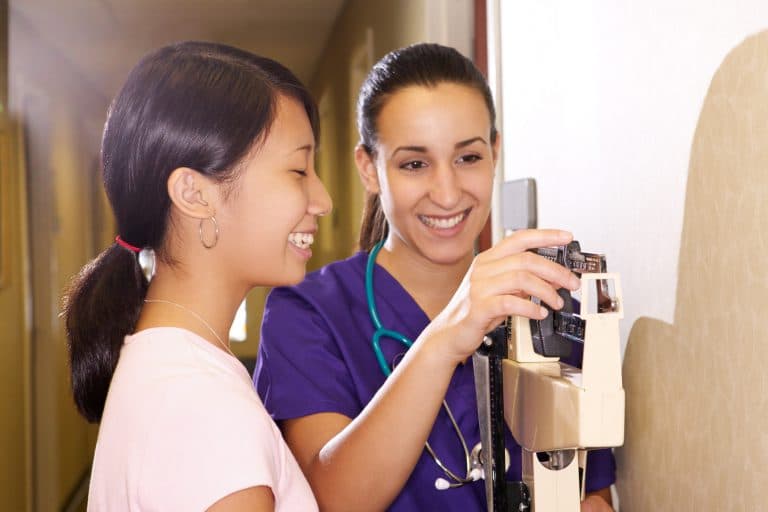Tweens, Teens and Young Adults Need Checkups Too
12.8.2016 | Heather Cooper

When parents get through the early years of teething, toilet training, temper tantrums, early growth spurts and endless viral seasons, they often stop scheduling annual checkups for their child. This is despite guidance from the American Academy of Pediatrics (AAP), which recommends one physical checkup and two dental checkups each year through the tween, teen and young adult years.
To understand the importance of these adolescent and young adult wellness visits Dr. Cora Collette Breuner, chairperson of the American Academy of Pediatrics’ Committee on Adolescence, as well as a pediatrician and adolescent medicine specialist at Seattle Children’s, provides the following advice to parents.
“Adolescents are the healthiest population statistically,” said Breuner. “And while that’s true, it’s also true that other than the first year of life, adolescence brings more rapid brain development and physical growth than any other period in an individual’s lifetime. With so many changes taking place, it’s important to work in partnership with your child’s doctor to monitor physical, sexual and emotional health and prevent risky behaviors.”
What happens during an adolescent wellness visit?
Checkups during adolescence include a physical exam, review of immunization records and screening tests, such as those for hearing, vision and blood pressure. In addition, health care providers are trained to weave in questions throughout the exam to pick up on concerns and to provide education on health, wellness and safety.
Breuner trains health care providers to use the HEADSS framework for this questioning. In HEADSS, the ‘H’ stands for home, the ‘E’ is for education, the ‘A’ is for activities, the ‘D’ is for drugs, the first ‘S’ is for sexuality, and the final ‘S’ is for safety.
These are examples of questions that might be asked during an exam:
- H: Who lives at home with you? Do you share a room? Do you eat meals as a family?
- E: Where do you go to school? How are your attendance and grades this year?
- A: What do you do after school? Tell me about your weekends? How much sleep do you get? Do you use social media?
- D: Have you tried drugs, alcohol or nicotine including e-cigarettes?
- S: Are you sexually active? What are you using for contraception if you are? What pronoun do you like to use for yourself? Are you attracted to the opposite sex, same sex or other?
- S: Do you feel safe at home? How do you cope with stress? If you’re dating, is your relationship healthy, consensual and safe? Have you ever thought about hurting yourself or others? Is someone hurting or bullying you verbally, on the internet, physically or sexually?
Creating strong doctor-patient relationships
The tween, teen and young adult wellness visits have another purpose – teaching adolescents how to increasingly take responsibility for their own health and wellness. The foundation for that transition is a strong relationship with their health care provider. For this reason, it’s normal for a child’s doctor to ask parents to step out of the room for a portion of the visit so they can talk privately and confidentially with the child.
“Parents need to be OK leaving the room for a few minutes during appointments, starting when kids are between 10 and 12,” said Breuner. “This allows kids to establish a relationship of trust with their health care provider.”
When parents are hesitant about leaving the exam room, Breuner tells them, “Your values are important and powerful, but sometimes other people are tugging at your family’s values when your child is out of your sight.” She reassures them by saying, “If I’m concerned about something I hear, I’ll tell you.”
Her agreement with her patients is, “Everything you say is confidential. However, you must know that it will go in your medical record, so other members of the medical community may be able to see notes if they need to as part of your future care. I will have to tell others if you may hurt yourself or someone else, or if someone is hurting you.”
Time alone with the provider gives adolescents a chance to become comfortable sharing health information and starts the process of them learning to manage their own health care – it’s a part of growing up.
Preparing for a visit
In order to make the most of the limited time available during a checkup, spend a few minutes writing down questions you have and helping your child prepare as well.
“Parents can prepare their child for visits by sharing examples of things the doctor will ask about,” said Breuner.
To prepare for a visit, teach your child to:
- Plan ahead by thinking of questions they would like to ask. Have them write them down and prioritize them. No issue is too small.
- Be honest when answering questions. Encourage them not to be shy – their doctor has heard it all before.
- Speak up if they don’t understand something. They can try repeating back in their own words to see if they understood what was said.
After the visit and beyond
After the visit, talk with your child about any follow up items and share back with other caregivers as appropriate. For older teens and young adults, teach them how to access their medical record.
“Young adults can use Twitter, Snapchat, all kinds of apps – help them gain confidence with accessing their medical records and taking responsibility for their own health care,” said Breuner.
Adults can be good role models for the adolescents in their lives by having annual health checkups themselves.
“Together, we’re teaching tweens, teens and young adults to be savvy health care consumers,” said Breuner.